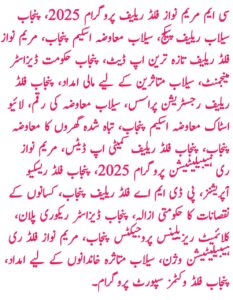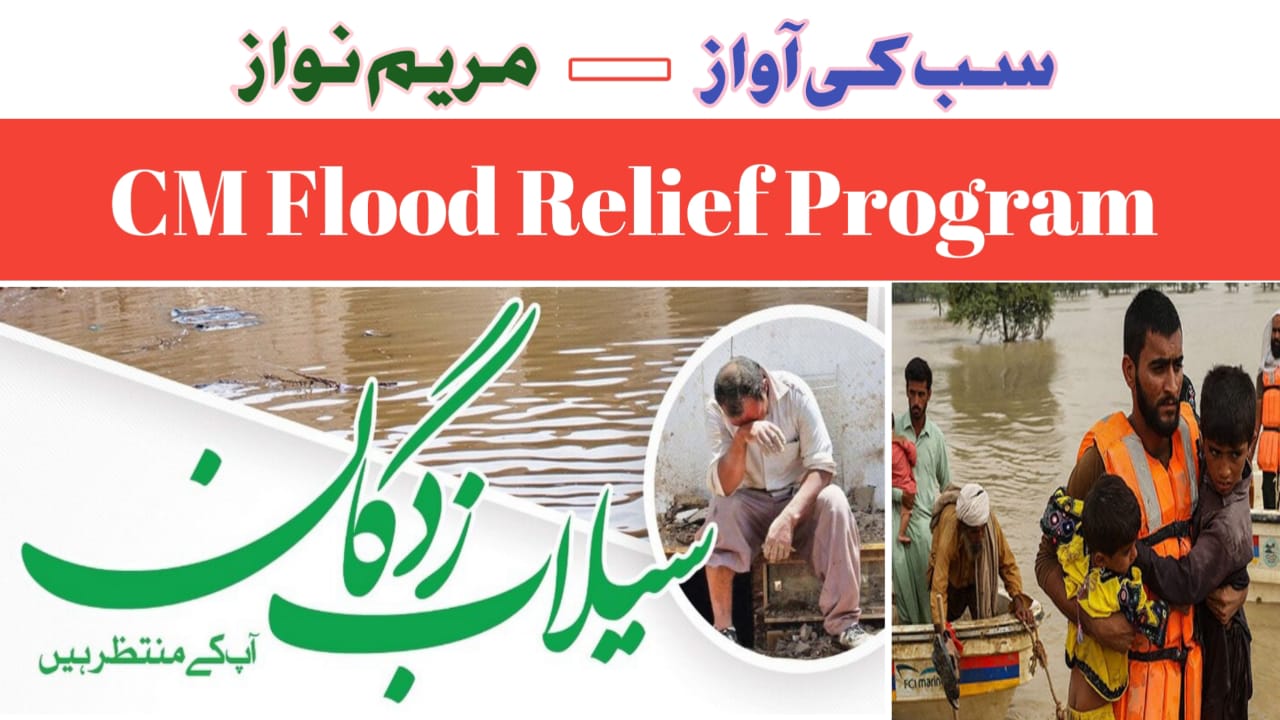CM Maryam Nawaz Flood Relief Program is one of the most destructive natural disasters, leaving behind a trail of destruction in the form of collapsed houses, destroyed crops, dead livestock, and displaced families. Each year, millions of people in South Asia are affected by heavy monsoon rains and overflowing rivers. In 2025, Punjab, Pakistan, once again faced one of the worst flood crises in recent memory, with millions of citizens losing their homes, land, and means of livelihood.
Recognizing the scale of human suffering, Chief Minister Maryam Nawaz Sharif announced a comprehensive Flood Relief Program 2025, designed not only to offer immediate financial assistance but also to ensure long-term rehabilitation and future protection against recurring disasters.
Unlike earlier relief programs that focused only on temporary shelter or ration distribution, this initiative is a complete recovery plan. It combines financial compensation, infrastructure repair, economic support for farmers, and climate resilience strategies to make Punjab stronger against future natural calamities.
This article provides a detailed breakdown of the program, including compensation amounts, eligibility, rescue operations, economic impact, and Maryam Nawaz’s long-term vision.
The Floods of 2025 – A Disaster of Unprecedented Scale
To fully understand the importance of the relief program, it is vital to examine the scale of the disaster:
- Heavy rainfall and water discharge from upstream dams submerged 8,400+ villages.
- More than 5.1 million people were directly affected.
- Around 1.8 million individuals had to evacuate their homes.
- Agricultural losses reached nearly 1 million acres of farmland.
- 66 people lost their lives, while thousands were injured or displaced.
- Farmers suffered heavy financial losses due to the death of cattle and the destruction of crops.
These figures highlight why a bold and immediate government response was essential.
CM Maryam Nawaz’s Flood Relief Program – Key Features
Maryam Nawaz declared that the Punjab government stands firmly with the victims and unveiled a structured plan with four main components:
1. Financial Compensation Packages
The most urgent need after a flood is financial help for survival and rebuilding. The CM announced direct cash assistance under the following categories:
- Rs 1,000,000 (1 million) – for families who lost a loved one.
- Rs 1,000,000 – for households whose homes were destroyed.
- Rs 500,000 – for partially damaged houses.
- Rs 500,000 – for the loss of large livestock (buffaloes, cows, camels).
- Rs 50,000 – for small livestock (goats, sheep, poultry).
This package ensures that families, widows, laborers, and farmers are not left alone during recovery.
2. Infrastructure and Rehabilitation Projects
Floods not only destroy homes but also damage public infrastructure. The Punjab government has committed to:
- Constructing a permanent embankment in Jalalpur Pirwala to protect against future flooding.
- Launching the Gillani Expressway for improved connectivity and quick disaster management.
- Strengthening riverbanks, irrigation systems, and drainage networks in flood-prone regions.
- Repairing schools, health centers, and public buildings affected by the disaster.
These measures will help reduce the long-term vulnerability of communities.
3. High-Level Relief and Monitoring Committee
To ensure transparency and efficiency, a 14-member Flood Relief Committee has been formed.
- Chaired by Senior Minister Marriyum Aurangzeb.
- Members include officials from Health, Irrigation, PDMA, Rescue 1122, Agriculture, and Finance departments.
Responsibilities:
- Assess damages.
- Verify victims for compensation.
- Monitor distribution of funds.
- Create a digital flood mapping system to identify vulnerable zones.
- Prepare a one-week action plan for rehabilitation.
This committee brings coordination and accountability, preventing corruption and ensuring aid reaches genuine victims.
4. Long-Term Climate Resilience and Disaster Preparedness
Maryam Nawaz emphasized that Punjab cannot afford short-term fixes. Her government has pledged to:
- Build climate-resilient housing for flood victims.
- Establish early warning systems for better preparedness.
- Train local communities in first aid and emergency evacuation techniques.
- Strengthen collaboration with NGOs, donors, and international development agencies.
This forward-looking approach transforms relief into sustainable recovery.

How to Claim Compensation
Flood victims must follow a step-by-step process to receive financial assistance:
- Register at local administration offices in affected districts.
- Provide valid CNIC, family details, and proof of damage (death certificates, photos of destroyed homes, or livestock records).
- Government officials conduct verification surveys.
- Compensation funds are transferred directly via banks or mobile wallet services.
This system reduces delays and prevents fraudulent claims.
Ongoing Rescue and Relief Operations
The Punjab government, with support from the Army, PDMA, and Rescue 1122, is running large-scale rescue missions:
- More than 1.8 million people evacuated to safe shelters.
- Emergency camps provide food, drinking water, and medical aid.
- Distribution of ration bags, tents, mosquito nets, and blankets.
- Deployment of boats and helicopters for rescue operations.
- Livestock vaccination campaigns to prevent outbreaks.
Maryam Nawaz personally visited camps, assuring citizens that no family would be left behind.
The Economic Impact of the Floods
The floods had a severe impact on Punjab’s economy:
- Standing crops destroyed: rice, cotton, sugarcane, and fodder.
- Farmers lost livestock, a vital income source in rural areas.
- Rural trade and transport were disrupted.
- Repair costs for irrigation canals and rural roads surged.
By compensating farmers and rebuilding infrastructure, the program aims to reduce economic suffering and restore productivity.
Challenges in Relief Distribution
Despite strong efforts, challenges remain:
- Large population displacement makes aid distribution complex.
- Verification delays due to a huge number of claims.
- Limited financial resources compared to the scale of losses.
- There is a need for inter-departmental coordination to avoid duplication or misuse.
The government is addressing these challenges by using digital verification tools and ensuring real-time monitoring of fund transfers.
Maryam Nawaz’s Vision – Turning Crisis into Opportunity
The CM believes this disaster can push Punjab toward modern flood management systems. Her vision includes:
- Stronger embankments and climate-proof housing.
- Technology-driven flood mapping and warning systems.
- Public-private partnerships to fund housing and rehabilitation projects.
- Training programs for rural communities in disaster preparedness.
- Sustainable agriculture initiatives to reduce crop losses in extreme weather.
This vision shows a shift from temporary relief to long-term resilience.
Why This Program Stands Out
- Human-Centered: Focuses on widows, farmers, and laborers.
- Transparent: Direct cash transfers ensure accountability.
- Comprehensive: Combines financial relief, infrastructure, and climate planning.
- Future-Oriented: Prevents recurrence instead of repeating temporary fixes.
Conclusion
The CM Flood Relief Program 2025, led by Maryam Nawaz Sharif, is not just a relief package — it is a lifeline of hope for millions of victims in Punjab. By offering financial aid, rebuilding infrastructure, and preparing communities for the future, this program reflects both compassion and leadership.
While challenges remain, the government’s proactive measures and long-term strategies promise a stronger, safer, and more resilient Punjab. For the people affected by the floods, this program is more than financial support — it is a promise of recovery, dignity, and a better tomorrow.
For More Information, Click Here
